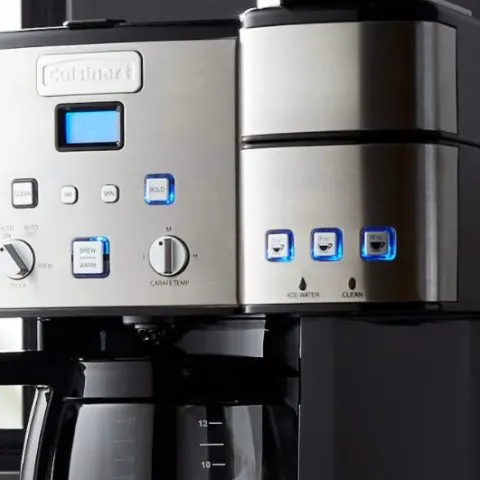Cleaning your Cuisinart Coffee maker is part of regular maintenance to ensure it remains in the best condition. Whether the machine has a self-cleaning option or not, you should clean it by decalcifying the water reservoir with vinegar and washing all other parts with warm soapy water. Proper cleaning will ensure you enjoy tasty coffee and maintain hygiene.
Failure to properly clean your coffee maker can result in mineral buildup affecting the quality of your brew.
What’s Required
- water
- vinegar
- liquid dish soap
- Clean towel
- sponge
- baking soda
Cleaning Procedure
It’s best to clean your Cuisinart coffee maker every three to six months, depending on how often you use it. Also, check your coffee maker’s instructions manual for the precise time to clean it and other precautionary measures to take.
-
Clean the Brew Basket
Even if you rinse your brew basket at the sink when you empty it, it’s best to go the extra mile to clean it thoroughly. Use warm soapy water to help take care of the oily residues left behind, leading to a bitter taste.
-
Clean Hot Plate or Drip Tray
Wait for the hot coffee plate to cool and wipe off any spilled coffee. To remove burnt coffee stains, scrub the plate with a damp sponge and baking soda. Also, for the drip tray where the mug sits, clean it with warm soapy water. Again, always ensure you empty it regularly.
-
Remove Mineral Deposits
The removal of mineral deposits is descaling a Cuisinart coffee maker. If your machine has a cleaning indicator, it will be blinking clean light as a sign to begin the process. Mineral deposits may clog your coffee maker tanks and tubes from your home water. If the residues are in excess, they may affect the machine operation, especially the brewing performance. Increased brew cycle and excessive steaming are signs that your machine is faulty.
Check this too: KitchenAid Coffee Maker Troubleshooting & How-to Guide
- Prepare a mixture of 2-part water and 1-parts vinegar and prepare enough for the reservoir capacity.
- Run the solution through the machine. You can use a carafe to measure and pour the solution.
- Run the brew cycle with water a couple of times to get rid of the vinegar taste before using the maker. Some brewers may have a Cuisinart coffee maker clean cycle, so always check the manual.
-
Press Clean Button
Press on the button to begin the cycle when the light glows. As the process ends, the machine beeps five times and turns off. The cycle takes 2-3 times more than the regular brew time.
-
Run a Brew Cycle
If your coffee maker doesn’t have a self-clean function. Fill the reservoir and run the machine just like you do when making coffee. To do a deep clean, switch off the device at half-way cycle and allow it to sit for an hour, later turn it on and let the process finish. If the maker still has buildup repeat, the cycle with a fresh solution of vinegar and water.
-
Rinse with Fresh Water
After the brew cycle, allow the machine to cool. Then add plain clean water and run a brew cycle to rinse the machine around 2-3 times.
-
Clean the Carafe
Clean the carafe with warm soapy water after every brew. To remove coffee stains, fill the carafe with a solution of one part baking soda and toe parts hot water, allow it to stand overnight. Rinse it well with water.
-
Wipe the Machine Body
Use a damp fabric cloth to clean the rest of the coffee maker and where the filter basket sits. When cleaning a Cuisinart coffee maker with a grinder, be careful to avoid splashing water onto the grinder motor as you wash it.
Here is a more detailed guide on how to clean an independent coffee grinder or the one attached to your coffee maker.
-
Reassemble the Coffee Maker
After cleaning all the machine parts, let them air dry or use a clean, dry towel. Later put all the elements in place as they were before.
Measures to Observe
- Never immerse the base unit of the machine in water or any liquid; it contains electrical equipment.
- Do not use scouring materials or harsh cleaners on any parts of the machine.
- Use pure filtered water in the descaling process. If you use tap water, you will be adding more minerals into the pot.
- While cleaning, the glass carafe becomes hot. To avoid damage, remember not to rinse it with cold water; instead, use warm water.
- Remember always to remove coffee grounds and filters from your machine before performing the cleaning process.
- Use a mixture of two-thirds water and one-third white vinegar instead of white vinegar as it’s potent.
Conclusion
These are the steps above to follow when you need to clean your coffee maker. Use the appropriate cleaning agents like a soft sponge, dish soap and avoid harsh cleaning agents. These robust cleaning solutions will damage your coffee maker. After cleaning, remember to dry it thoroughly.
Check this too: How to Clean a Window Air Conditioner

